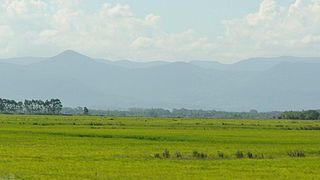
Buenos Aires, officially the Buenos Aires Province, is the largest and most populous Argentine province. It takes its name from the city of Buenos Aires, the capital of the country, which used to be part of the province and the province's capital until it was federalized in 1880. Since then, in spite of bearing the same name, the province does not include Buenos Aires proper, though it does include all other parts of the Greater Buenos Aires metropolitan area. The capital of the province is the city of La Plata, founded in 1882.

The Pampas are fertile South American low grasslands that cover more than 1,200,000 square kilometres (460,000 sq mi) and include the Argentine provinces of Buenos Aires, La Pampa, Santa Fe, Entre Ríos, and Córdoba; all of Uruguay; and Brazil's southernmost state, Rio Grande do Sul. The vast plains are a natural region, interrupted only by the low Ventana and Tandil hills, near Bahía Blanca and Tandil (Argentina), with a height of 1,300 m (4,265 ft) and 500 m (1,640 ft), respectively.

Argentina has a vast territory and a variety of climates and microclimates ranging from tundra and polar in the south to the tropical climate in the north, through a vast expanse of temperate climate. Natural wonders include the Aconcagua, the highest mountain in the world outside the Himalayas, the widest river and estuary of the planet, the Iguazú Falls, the Humid Pampas, and the Argentine Sea. Visitors enjoy the culture, customs and Argentine cuisine.

Santa Cruz Province is a province of Argentina, located in the southern part of the country, in Patagonia. It borders Chubut Province to the north, and Chile to the west and south, with an Atlantic coast on its east. Santa Cruz is the second-largest province of the country, and the least densely populated in mainland Argentina.

Carlos Thays was a French-Argentine landscape architect, and a student of French landscape architect Édouard André.

The following is an alphabetical list of topics related to the Argentina.

The Tehuelche people, also called the Aónikenk, are an indigenous people from eastern Patagonia in South America. In the 18th and 19th centuries the Tehuelche were influenced by Mapuche people, and many adopted a horseriding lifestyle. Once a nomadic people, the lands of the Tehuelche were colonized in the 19th century by Argentina and Chile, gradually disrupting their traditional economies. The establishment of large sheep farming estates in Patagonia was particularly detrimental to the Tehuelche. Contact with outsiders also brought in infectious diseases ushering deadly epidemics among Tehuelche tribes. Most existing members of the group currently reside in cities and towns of Argentine Patagonia.

Sierra de La Ventana is a village in Tornquist Partido in the southwest of the Province of Buenos Aires, Argentina. With a population of 1,819 inhabitants, it is one of the most attractive tourist centres in the Province and has numerous recreation areas and parks.

Tornquist is a town in Buenos Aires Province, Argentina. It is the head town of the Tornquist Partido.

The Sierra de la Ventana is a mountain range in Buenos Aires Province, and one of only two located within the Pampas ecosystem.

Cerro de la Neblina, also known as Serra da Neblina in Brazil and Sierra de la Neblina in Venezuela, is a sandstone massif located in the northern Amazon Basin. It is a tilted, heavily eroded plateau, with a deep canyon in its central portion, drained by the Baria River.

Córdoba is a province of Argentina, located in the center of the country. Its neighboring provinces are Santiago del Estero, Santa Fe, Buenos Aires, La Pampa, San Luis, La Rioja, and Catamarca. Together with Santa Fe and Entre Ríos, the province is part of the economic and political association known as the Center Region.
Antonietta Paule Pepin Fitzpatrick, also known as Nenette, was a French composer, pianist and lyricist.

National Primary Route 2, formally known as Carretera Interamericana Sur, is the southern segment of the Pan-American Highway that traverses Costa Rica.

Alberto Emilio Asseff is an Argentine lawyer and politician who served a National Deputy between 2011 and 2015, reassuming office in 2019.

The Cerro Azul Formation, in the Buenos Aires Province also described as Epecuén Formation, is a geological formation of Late Miocene age in the Colorado Basin of the Buenos Aires and La Pampa Provinces in northeastern Argentina.

In mid-January 2022, the Southern Cone had a severe heat wave, which made the region for a while the hottest place on earth, with temperatures exceeding those of the Middle East. This extreme weather event was associated with the Atlantic anticyclone, a particularly intense La Niña phenomenon in the Pacific Ocean, and the regional effects of climate change.

















